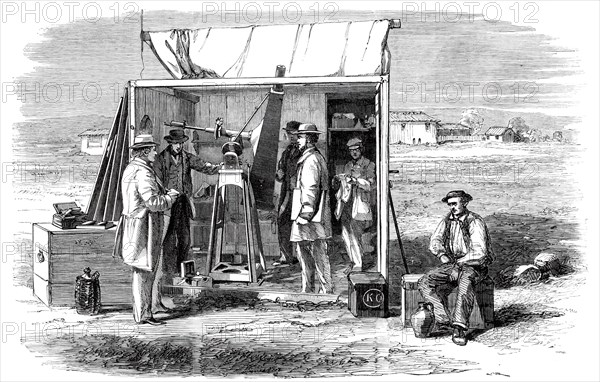
Sujet
The Kew Photoheliograph and Temporary Observatory at Rivabellosa, near Miranda del Ebro, 1860. Creator: Unknown.
Légende
The Kew Photoheliograph and Temporary Observatory at Rivabellosa, near Miranda del Ebro, [Spain], 1860. 'The Kew photoheliograph consists of a tube having the form of a truncated pyramid, at the smaller (upper) end of which is fixed the object-glass, 3 4-10 inches in diameter, and 50 inches focal length. The focal image of the sun formed by the object-glass is 47-100ths of an inch in diameter; but before it is allowed to fall on the sensitive plate it is enlarged, by means of a secondary combination of lenses, to four inches in diameter. The image is thus magnified about eight times linear, and the intensity of its light diminished 64 times. The sensitive plates, six inches square, are placed at the large end of the pyramidal tube of the telescope. The tube is what is termed equatorially mounted, and is made to follow the diurnal motion of the sun by means of clockwork. The plates being only six inches square, while the sun's image is 4 inches in diameter, it will be seen that only a small extent of the corona could be depicted. I mention this in order that there may be no misconception on this point: had I desired to make photographs of the whole of the corona, I should have adopted a totally different arrangement'. From "Illustrated London News", 1860.
Crédit
Photo12/Heritage Images/The Print Collector
Notre référence
HRM23B07_483
Model release
NA
Property release
NA
Licence
Droits gérés
Format disponible
44,9Mo (4,0Mo) / 42,0cm x 26,8cm / 4960 x 3161 (300dpi)